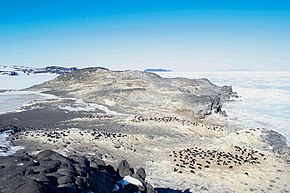Cape Royds
| Cape Royds | ||
 |
||
| Geographical location | ||
|
|
||
| Coordinates | 77 ° 34 ′ S , 166 ° 9 ′ E | |
| location | Ross Island ( Ross Archipelago , Antarctica ) | |
| Waters | McMurdo Sound | |
| Waters 2 | Wohlschlag Bay | |
 Ross Island with Cape Royds |
||
Cape Royds ( English Cape Royds ) is the western cape of the Antarctic Ross Island in McMurdo Sound . It was discovered during the British Discovery Expedition (1901-1904) and named after Lieutenant Charles WR Royds of the Royal Navy , who served as an expedition meteorologist . The cape was the location of the base camp of the Nimrod expedition (1907-1909) of the British polar explorer Ernest Shackleton, which has been preserved to this day .
Cape Royds is home to the southernmost breeding colony of the Adelie penguin with a population that varies between 2500 and 4500 pairs. After a drastic decline in the population to less than 1000 breeding pairs in 1963, the first protective measures were taken. Today the colony and the adjacent marine area form the specially protected area of Antarctica No. 121 "Cape Royds, Ross Island" ( Antarctic Specially Protected Area No. 121 ) and may not be entered or flown over without a permit. The protected area is also a custodian of the Nimrod Expedition from 1908. Shackleton's hut belongs to the adjacent reserve ASPA-157 "Backdoor Bay" and is also called Historical sites and monuments no. 15 ( Historical Site and Monument No. 15 ) out.
Adelie penguins at Cape Royds
Web links
Individual evidence
- ^ ASPA 121: Cape Royds, Ross Island in the Antarctic Protected Areas Database on the Antarctic Treaty Secretariat website (English, Spanish, French, Russian), accessed November 16, 2019
- ↑ HSM 15: Shackleton's Hut in the Antarctic Protected Areas Database on the Antarctic Treaty Secretariat website (English, Spanish, French, Russian), accessed November 16, 2019



